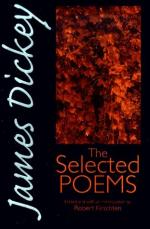|
This section contains 3,710 words (approx. 13 pages at 300 words per page) |

|
SOURCE: Baughman, Ronald. “Buckdancer's Choice.” In Understanding James Dickey, pp. 62-77. Columbia: University of South Carolina Press, 1985.
In the following essay, Baughman examines the principal poems of Buckdancer's Choice, illuminating significant themes and mentioning Dickey's sustained evocation of human ambivalence and equivocation.
In Buckdancer's Choice Dickey achieves full maturity as a poet. These are exciting poems, many of them discernibly longer, less constricted in form, more “open” than his previous works. In his essay “The Poet Turns on Himself,” Dickey defines his concept of the “un-well-made” or “open” poem: “It would have none of the neatness of most of those poems we call ‘works of art’ but would have the capacity to involve the reader in it, in all its imperfections and impurities, rather than offering him a (supposedly) perfected and perfect work for contemplation, judgment, and evaluation.”1 The “open,” or more conclusionless, poem not only creates the...
|
This section contains 3,710 words (approx. 13 pages at 300 words per page) |

|


